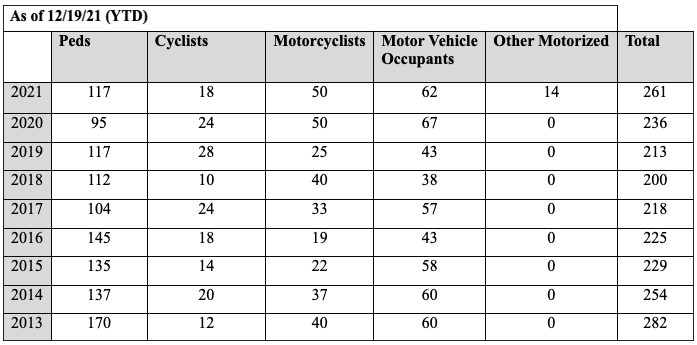The Streetsies are back! After a year off for Covid, we’ve decided to fully bring back our beloved end-of-year awards show to honor the heroes of the livable streets movement, wag a finger at the villains, and generally roundup a year’s worth of events and projects that you might have forgotten. All week long, we’ve be rolling out this year’s awards. Click here for the archive.

Promises, promises, promises! The state and city Departments of Transportation, the Metropolitan Transportation Authority, and the legislature in Albany are all supposed to work expeditiously to achieve and maintain safe, accessible and equitable streets and transit. So how come so many priority projects, bills or even laws miss their marks when it comes to self-imposed deadlines — or never happen at all? Here's a compendium of needed projects, legislation and mandates that stalled.
The watered-down Fifth Avenue busway
The city DOT said in 2020 that it would build a busway on swanky Fifth Avenue from 57th to 34th streets — one of five such thoroughfares that it promised after the phenomenal success of the city's initial busway on 14th Street. Then, however, the DOT repeatedly hemmed and hawed and backtracked on the project, which would hasten commutes for almost 110,000 daily riders, because mom-and-pops such as Armani, Dolce and Gabbana, Tiffany and Co., Coach, and Rolex voiced concerns about restricting private cars on the avenue. Next, the department watered the busway down. At last sighting, it had punt the much-delayed project after Hizzoner met with billionaire political macher Steve Ross, as the Times memorably reported.
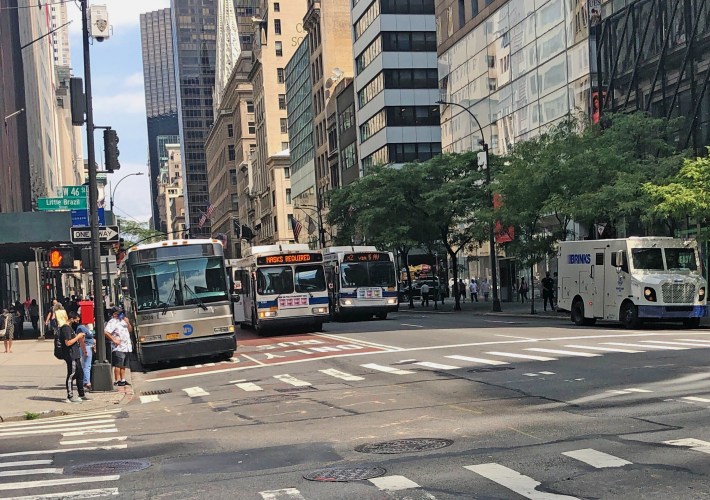
Hello, Mayor Adams, could you please step up to the plate and support beleaguered straphangers — instead of pandering to the super rich?
The tottering BQE
Charged in 2019 with finding a solution for the decrepit BQE, the Robert Moses-built monstrosity that is in danger of collapsing soon, Mayor de Blasio did what all dithering bureaucrats do: He sent the question to a commission. The panel urged that the city reduce the weight on the most endangered part of the highway by getting rid of two vehicle lanes, but the mayor blanched — what, curtail space for cars?
Instead, in order to "buy time" for the doomed road, he and the DOT devised a plan to reduce the traffic somewhat less and caulk it together, essentially with spit and tissue, thus kicking the can down the road for another 20 years. Punt, punt, punt!

Now, even the head of de Blasio's defunct BQE panel is calling for the city to tear down the mistake and start fresh. But again, that’s in Mayor Adams’s hands.
Inaction on the 'Carpocalypse'
We hate to say "we told you so" (hmmm, maybe we don't) but the mayor's own Covid-recovery surface transportation panel, as well as these pages, sounded the alarm again and again in the last two years that the city's inaction on policies to curtail private car use in the city (HOV lanes, encouraging transit use via lower fares, at least 40 miles of emergency bus lanes, among others) would lead to congested streets and a surge in road violence. The mayor, wary of the car lobby, didn't act.
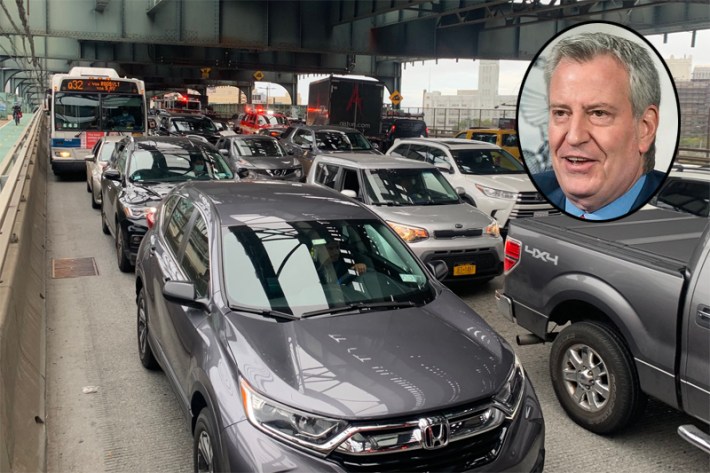
Well, whaddya know? Everyone and his brother is writing articles on how bad the traffic is. More to the point, however, this year was the bloodiest one in terms of traffic violence of de Blasio's tenure, with 261 dead and counting, up from the gold-standard Vision Zero year of 2018, which recorded "only" 200 fatalities. The statistic points to the essential lie of de Blasio's "Tale of Two Cities" promise: The small minority of car owners that the mayor consistently has appeased tend to be richer than other New Yorkers.
And the victims of road violence tend to be the less-fortunate.
Albany's epic fail on street safety
In June, lawmakers slunk out of the capital without having enacted crucial, life-saving bills, including the eight-bill package of the Crash Victims Rights and Safety Act. "Sammy's Law," named for young traffic-violence victim Samuel Cohen Eckstein, would enable cities to lower speed limits without asking Albany.
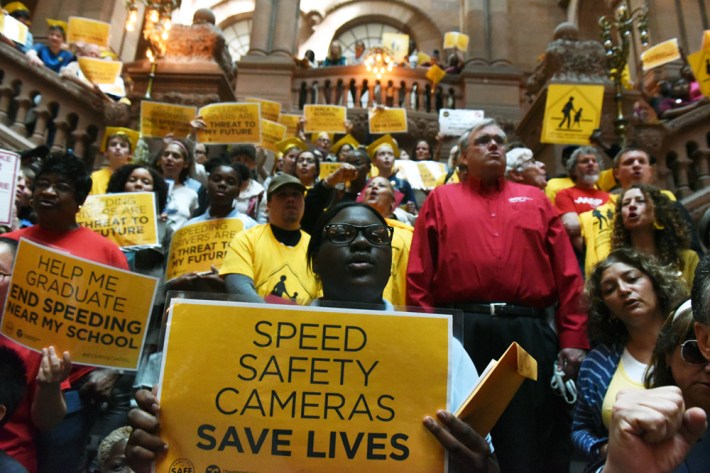
Other legislation would require motorists to give cyclists ample room when they pass, create a new way of rating car safety, make it easier to prosecute reckless drivers, lower the acceptable blood-alcohol level, and improve driver education, and authorize speed cameras 24-7-365. Still another bill that languished would have allowed for wider cargo bikes, which is seen as critical for companies such as Amazon, UPS and DHL that hope to start a delivery-bike revolution.
They have something better to do up there?
Unfinished bike lanes
Fourth Avenue in Brooklyn. The streets around Washington Square in Manhattan. Eighth Avenue in Midtown. It's Dec. 24, DOT — long past time that the road crews are out. Do you know where your bike-lane stripes are? People are complaining all over town that the DOT just didn't get around to finishing a number of important stripings — endangering the lives of cyclists who depend on the lanes. As one longtime observer put it, "Huge chunks of the city's bike lane network [have been] wiped out by sheer incompetence." What gives?
Un-striped and half-finished bike lanes all over NYC currently. And it looks like @NYC_DOT won’t get them done until spring. This is an alarming failure of the most basic function of municipal government. Huge chunks of the city’s bike network wiped out by sheer incompetence. https://t.co/jztvmpPkjh
— Aaron Naparstek (@Naparstek) December 6, 2021
And since "painting season" is done until April, that's a long time for people to wait for safety.
Delays on key safety projects
On the Queensboro Bridge, the city’s conversion of a car lane to a dedicated pedestrian path won't finish until at least late 2022 because the DOT won't inconvenience motorists by closing a lane during the construction — and so cyclists and walkers must continue to share a dangerous, narrow lane for the duration, multiplying crashes.
On Emmons Avenue in Sheephead Bay, Brooklyn, the DOT stalled a needed bike-lane connection to a world-famous beach, apparently because of the objections of a City Council member who later got expelled for criminality. That project should have been completed years ago.
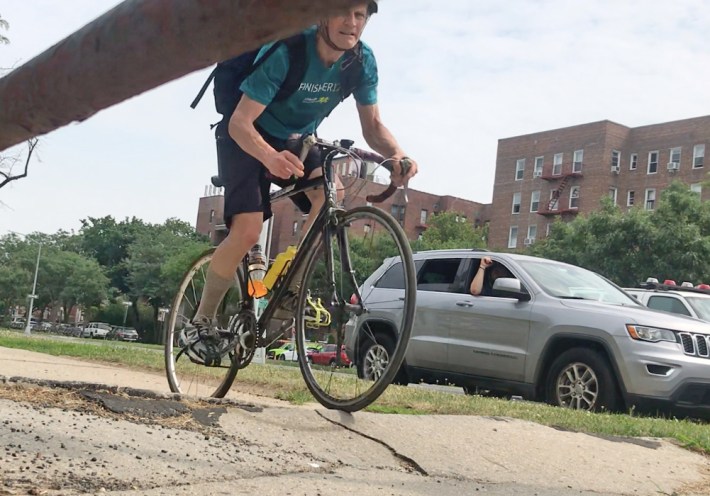
The rebuilding of the treacherous, broken pavement of the Ocean Parkway bike path in Brooklyn — a Parks Department fail of several years' standing — has been delayed yet again, this time with the excuse of Covid. (And the delays of earlier years owed to what?)
These are just a few examples — we could name more! All these delays point to the classic flaws of New York City government: bureaucratic torpor, polymorphous disorganization, political pusillanimity, rampant silo-ization, endemic finger-pointing, just-plain-old dithering.
Is there any cure?
The failure to maintain open streets
With yet another Covid-19 surge bearing down upon us — in the form of the Omicron variant, which is many times more contagious than the original disease — New Yorkers will need a place to breathe and recreate freely outside of their postage-stamp-sized apartments. That was the original impetus behind the city's open streets — and that's why it's a crying shame that so many open streets, starved of personnel and resources to maintain them and sabotaged by the vandalism of motorists, failed on the DOT's watch.
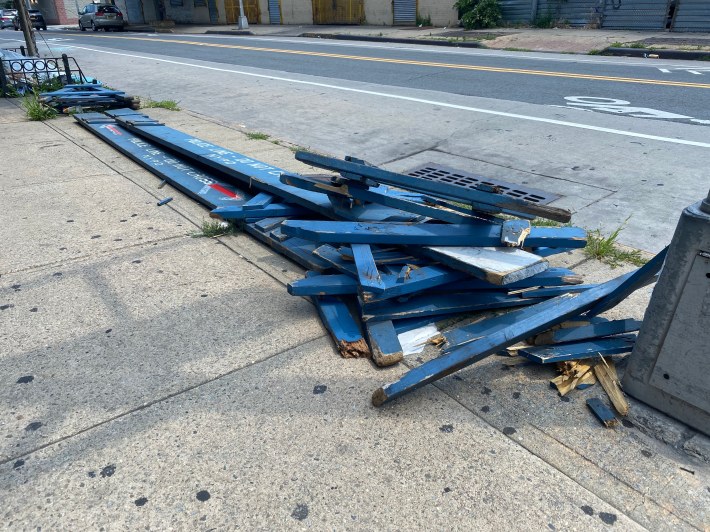
In October, more than a year into the program, Transportation Alternatives reported that only 126 out of 274 open streets were functional. Moreover, despite a de Blasio administration promise to create 100 miles of open streets, the city has less than 24 miles. Incoming Mayor Adams has pledged to bring more open streets to the impoverished neighborhoods that most urgently need them. He will have his work cut out for him because the city has learned that the "best" open streets require massive volunteer efforts.
And the current DOT's effort to make the best ones permanent are also flawed.
The missing ‘Bike Mayor’
In 2019, Council Members Ydanis Rodriguez (then the Transportation Committee chairman, soon to be the transportation commissioner) and Carlina Rivera (Manhattan) proposed that the city establish Offices of Active Transportation and Pedestrians — in short, that the city should train a special focus on bikers and walkers. The bills for both measures got laid over in committee, and with it the idea of a "bike mayor" who would champion the interests of the growing legion of city cyclists. Given that the importance of active transportation to the very survival of the city, it's a telling omission.
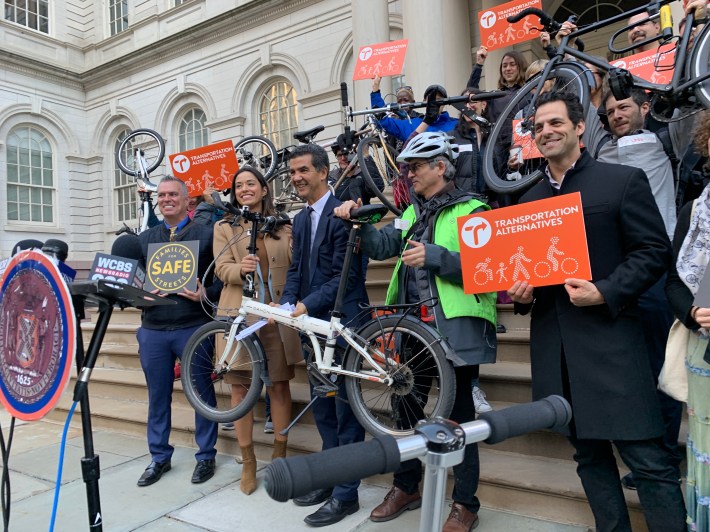
And the Streetsie goes to...
Inaction on the carpocalypse!
Sure, what's infuriating about the massive increase in car driving is that Mayor de Blasio was warned so many times that the collapse of transit would lead to way more driving. But the most infuriating part of it is how all that massive increase in driving has also led to far more road deaths than in previous years — 2021 will go down in history as the bloodiest year of Mayor de Blasio's Vision Zero initiative. The mayor did not do enough in calendar year 2021 to prevent that.
